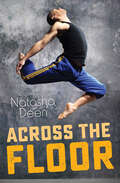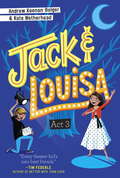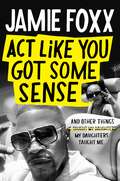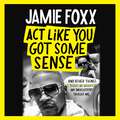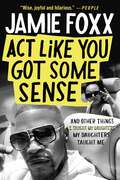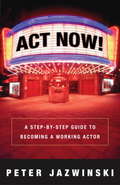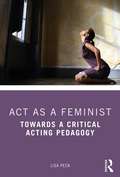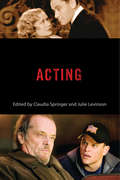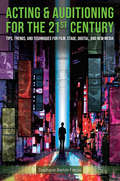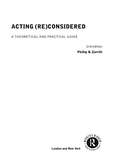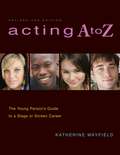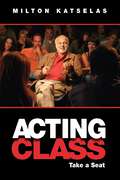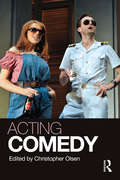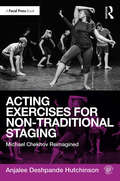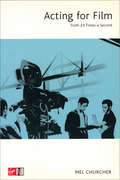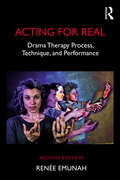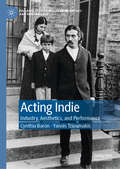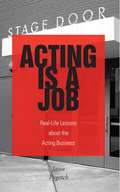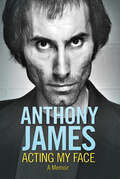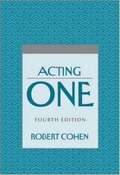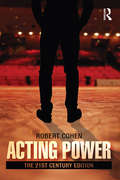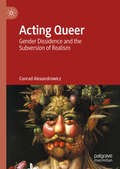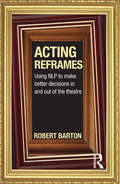- Table View
- List View
Across the Floor (Orca Limelights)
by Natasha DeenLuc Waldon always figured he knew what his passion was: football. Luc lives it, he breathes it—and he thinks he has what it takes to go all the way to the NFL. So when his football coach orders him to sign up for contemporary-dance classes to improve his game, Luc's less than thrilled. When he realizes that dance might actually be his true passion, he faces a tough decision. Is he willing to leave behind the field and a real shot at professional sports, and disappoint his parents, his coach and his teammates, in order to pursue a new dream? This short novel is a high-interest, low-reading level book for middle-grade readers who are building reading skills, want a quick read or say they don’t like to read!
Act 3
by Kate Wetherhead Andrew Keenan-Bolger Ben KirchnerA show-stopping middle-grade series about life in and out of the spotlight from Broadway stars and Internet sensations Andrew Keenan-Bolger and Kate Wetherhead.Two weeks at Camp Curtain-Up is just what Jack and Louisa need to fuel their passion for theater: Broadway musical sing-alongs, outdoor rehearsals, and tons of new MTNs (musical theater nerds) to meet... maybe even a special someone. It almost feels like fate when the two friends return home to find local auditions for The Sound of Music. But as Louisa fantasizes about frolicking in the Alps, Jack gets tempted by a student-run drama competition that would reunite the two with their camp friends. Will Jack get Louisa to skip an audition? Can Lou handle Jack as her director? And will someone finally get a big, Broadway happy ending?
Act Like You Got Some Sense
by Jamie FoxxFrom Academy Award-winning multi-talent Jamie Foxx, a hilariously candid look at the joys and pitfalls of being the father of two daughters. Jamie Foxx is not only an actor, comedian, and musician, he's also starring in his most humbling and long-running role yet as father to two independent girls: Corinne and Anelise. While his daughters have very different views on the world, there is one thing they can agree on: Dad gets on their motherf***ing nerves. Though every day with his girls brings hurdles and hilarity, he's learned a lot along the way. In ACT LIKE YOU GOT SOME SENSE - a title inspired by his beloved and fierce grandmother - Jamie reveals his rocky parenting journey through priceless stories about the tough love and old-school values he learned growing up in the small town of Terrell, Texas; his early days trying to make it in Hollywood; and life after achieving stardom. You would think being an A-lister would ease his dad-duty struggles, but if anything, it has only made things more complicated. It seems that a teenage girl who just wants to blend in with her friends will not be excited to see her dad's flashy new convertible at the front of the carpool lane. Hilarious, poignant, and always brutally honest, ACT LIKE YOU GOT SOME SENSE is Jamie Foxx like we've never seen him before, dealing with problems he never imagined he'd have.
Act Like You Got Some Sense
by Jamie FoxxFrom Academy Award-winning multi-talent Jamie Foxx, a hilariously candid look at the joys and pitfalls of being the father of two daughters. Jamie Foxx is not only an actor, comedian, and musician, he's also starring in his most humbling and long-running role yet as father to two independent girls: Corinne and Anelise. While his daughters have very different views on the world, there is one thing they can agree on: Dad gets on their motherf***ing nerves. Though every day with his girls brings hurdles and hilarity, he's learned a lot along the way. In ACT LIKE YOU GOT SOME SENSE - a title inspired by his beloved and fierce grandmother - Jamie reveals his rocky parenting journey through priceless stories about the tough love and old-school values he learned growing up in the small town of Terrell, Texas; his early days trying to make it in Hollywood; and life after achieving stardom. You would think being an A-lister would ease his dad-duty struggles, but if anything, it has only made things more complicated. It seems that a teenage girl who just wants to blend in with her friends will not be excited to see her dad's flashy new convertible at the front of the carpool lane. Hilarious, poignant, and always brutally honest, ACT LIKE YOU GOT SOME SENSE is Jamie Foxx like we've never seen him before, dealing with problems he never imagined he'd have.
Act Like You Got Some Sense: And Other Things My Daughters Taught Me
by Jamie FoxxIn this hilarious and heartfelt memoir, award-winning, multi-talented entertainer Jamie Foxx shares the story of being raised by his no-nonsense grandmother, the glamour and pitfalls of life in Hollywood, and the lessons he took from both worlds to raise his two daughters.Jamie Foxx has won an Academy Award and a Grammy Award, laughed with sitting presidents, and partied with the biggest names in hip-hop. But he is most proud of his role as father to two very independent young women, Corinne and Anelise. Jamie might not always know what he&’s doing when it comes to raising girls—especially when they talk to him about TikTok (PlikPlok?) and don&’t share his enthusiasm for flashy Rolls Royces—but he does his best to show up for them every single day.Luckily, he has a strong example to follow: his beloved late grandmother, Estelle Marie Talley. Jamie learned everything he knows about parenting from the fierce woman who raised him: As he puts it, she&’s &“Madea before Tyler Perry put on the pumps and the gray wig.&” In Act Like You Got Some Sense—a title inspired by Estelle—Jamie shares up close and personal stories about the tough love and old-school values he learned growing up in the small town of Terrell, Texas; his early days trying to make it in Hollywood; the joys and challenges of achieving stardom; and how each phase of his life shaped his parenting journey. Hilarious, poignant, and always brutally honest, this is Jamie Foxx like we&’ve never seen him before.
Act Now! A Step-by-step Guide to Becoming a Working Actor
by Peter JazwinskiSo, you want to be an actor . . . but you have no idea how to get started. In the pages of Act Now!, you'll find a step-by-step process to show you not only how to get started, but also how to become a working actor. It will take time and commitment, but if you follow these steps you will find success. Author and acting teacher Peter Jazwinski explains every aspect of becoming an actor from start to finish. You'll learn about: * Improving Your Acting Skills * How Actors Get Cast * Finding Auditions on Your Own * Working with an Agent or Manager--and What the Difference Is * The Importance of Networking * And More! A frank and encouraging game plan for success,Act Now!will empower those who have the drive to stop dreaming and start making a living--as an actor.
Act as a Feminist: Towards a Critical Acting Pedagogy
by Lisa PeckAct as a Feminist maps a female genealogy of UK actor training practices from 1970 to 2020 as an alternative to traditional male lineages. It re-orientates thinking about acting through its intersections with feminisms and positions it as a critical pedagogy, fit for purpose in the twenty-first century. The book draws attention to the pioneering contributions women have made to actor training, highlights the importance of recognising the political potential of acting, and problematises the inequities for a female majority inspired to work in an industry where they remain a minority. Part One opens up the epistemic scope, shaping a methodology to evaluate the critical potential of pedagogic practice. It argues that feminist approaches offer an alternative affirmative position for training, a via positiva and a way to re-make mimesis. In Part Two, the methodology is applied to the work of UK women practitioners through analysis of the pedagogic exchange in training grounds. Each chapter focuses on how the broad curriculum of acting intersects with gender as technique to produce a hidden curriculum, with case studies on Jane Boston and Nadine George (voice), Niamh Dowling and Vanessa Ewan (movement), Alison Hodge and Kristine Landon-Smith (acting), and Katie Mitchell and Emma Rice (directing). The book concludes with a feminist manifesto for change in acting. Written for students, actors, directors, teachers of acting, voice, and movement, and anyone with an interest in feminisms and critical pedagogies, Act as a Feminist offers new ways of thinking and approaches to practice.
Acting
by Cynthia Baron David Sterritt Claudia Springer Arthur Nolletti Jr. Donna Peberdy Julie Levinson Victoria DuckettScreen performances entertain and delight us but we rarely stop to consider actors' reliance on their craft to create memorable characters. Although film acting may appear effortless, a host of techniques, artistic conventions, and social factors shape the construction of each role. The chapters in Acting provide a fascinating, in-depth look at the history of film acting, from its inception in 1895 when spectators thrilled at the sight of vaudeville performers, Wild West stars, and athletes captured in motion, to the present when audiences marvel at the seamless blend of human actors with CGI. Experts in the field take readers behind the silver screen to learn about the craft of film acting in six eras: the silent screen (1895-1928), classical Hollywood (1928-1946), postwar Hollywood (1947-1967), the auteur renaissance (1968-1980), the New Hollywood (1981-1999), and the modern entertainment marketplace (2000-present). The contributors pay special attention to definitive performances by notable film stars, including Lillian Gish, Dick Powell, Ginger Rogers, Beulah Bondi, Marilyn Monroe, Marlon Brando, Jack Nicholson, Robert De Niro, Nicholas Cage, Denzel Washington, and Andy Serkis. In six original essays, the contributors to this volume illuminate the dynamic role of acting in the creation and evolving practices of the American film industry. Acting is a volume in the Behind the Silver Screen series--other titles in the series include Animation; Art Direction and Production Design; Cinematography; Costume, Makeup, and Hair; Directing; Editing and Special/Visual Effects; Producing; Screenwriting; and Sound.
Acting & Auditioning for the 21st Century: Tips, Trends, and Techniques for Digital and New Media
by Stephanie Barton-FarcasActing & Auditioning for the 21st Century covers acting and auditioning in relation to new media, blue and green screen technology, motion capture, web series, audiobook work, evolving livestreamed web series, and international acting and audio work. Readers are given a methodology for changing artistic technology and the global acting market, with chapters covering auditions of all kinds, contracts, the impact of new technology and issues relating to disabled actors, actors of colour and actors that are part of the LGBTQIA community.
Acting (Re)Considered (Re)Considered: A Theoretical and Practical Guide
by Phillip B. ZarrilliActing (Re)Considered is an exceptionally wide-ranging collection of theories on acting, ideas about body and training, and statements about the actor in performance. This second edition includes five new essays and has been fully revised and updated, with discussions by or about major figures who have shaped theories and practices of acting and performance from the late nineteenth century to the present.The essays - by directors, historians, actor trainers and actors - bridge the gap between theories and practices of acting, and between East and West. No other book provides such a wealth of primary and secondary sources, bibliographic material, and diversity of approaches. It includes discussions of such key topics as:* how we think and talk about acting* acting and emotion* the actor's psychophysical process* the body and training* the actor in performance* non-Western and cross-cultural paradigms of the body, training and acting.Acting (Re)Considered is vital reading for all those interested in performance.
Acting A to Z: The Young Person's Guide to a Stage or Screen Career - Revised 2nd Edition
by Katherine MayfieldLots of kids want to be actors. Thousands of them. Millions of them. The ones who are serious need a copy of Acting A to Z. Industry insider Katherine Mayfield explains exactly what it’s like to be an actor, including what kind of training the young person will need, comparisons of the different types of acting, how to find work, how to prepare for an audition, and what to expect during rehearsal. There’s also tons of helpful information on unions, casting directors, headshots, resumes, and much more. Reassuring without being patronizing, Acting A to Z is the one book that every aspiring child actor needs.
Acting Class: Take a Seat
by Milton KatselasJim Carrey, Kyle Chandler, George Clooney, Ted Danson, Kate Hudson, Justina Machado, Michelle Pfeiffer, and Tom Selleck are just some of the many celebrated actors who have benefited from the legendary acting teacher Milton Katselas. As the founder of the prestigious Beverly Hills Playhouse, Katselas was regarded by many as one of America's foremost acting teachers as well as an acclaimed director. Originally available only to students at the Beverly Hills Playhouse, Acting Class: Take a Seat presents the concepts and methods that helped lead a generation of actors to success on stage, in cinema, and on television. In this all-encompassing book, Katselas invites readers to “sit in” on the classes he taught for more than forty years. Acting Class covers in detail three concepts central to the Katselas approach: Acting, Attitude, and Administration. Katselas not only covers techniques and methods, but also includes valuable discussions on the attitudes any artist needs to fulfill their dreams.
Acting Comedy
by Christopher OlsenDespite being roundly cited as much harder to perform than its dramatic counterpart, comic acting is traditionally seen as a performance genre that can’t be taught. At best it is often described as a skill that can only be learned "on the job" through years of practice, or given to a performer through natural talent. Acting Comedy is an effort to examine this idea more rigorously by looking at different aspects of the comic actor’s craft. Each chapter is written by an expert in a particular form—from actors and directors to teachers and standup comedians. Topics covered include: how performers work with audiences how comic texts can be enhanced through word and musical rhythm analysis how physical movements can generate comic moments and build character. This book is an invaluable resource for any performer focusing on the minute details of comic acting, even down to exactly how one delivers a joke on stage. Christopher Olsen’s unique collection of comic voices will prove essential reading for students and professionals alike.
Acting Exercises for Non-Traditional Staging: Michael Chekhov Reimagined
by Anjalee Deshpande HutchinsonActing Exercises for Non-Traditional Staging: Michael Chekhov Reimagined offers a new set of exercises for coaching actors when working on productions that are non-traditionally staged in arenas, thrusts, or alleys. All of the exercises are adapted from Michael Chekhov's acting technique, but are reimagined in new and creative ways that offer innovative twists for the practitioner familiar with Chekhov, and easy accessibility for the practitioner new to Chekhov. Exploring the methodology through a modern day lens, these exercises are energizing additions to the classroom and essential tools for more a vibrant rehearsal and performance.
Acting For Film
by Mel ChurcherThe author uses her wide experience as an acting and voice coach an major movies to offer insights into the film acting process. She provides tasks, techniques and tips that are designed specifically for film: there's advice to make the first-time film actor feel at home on set, tips on the casting process, how to cope with auditions, on-camera techniques, schedules and shooting order, as well as specific advice from film crews to help an actor's performance. This practical workbook combines exercises and anecdotes in an informal and accessible style, making it the indispensable guide for anyone wishing to light up the silver screen.
Acting For Real: Drama Therapy Process, Technique, And Performance
by Renée EmunahThis second edition takes the reader further into the heart of using drama for healing. Dr. Emunah offers an expanded understanding of her Integrative Five Phase model, a foundational approach that embraces the wide spectrum of possibilities within the playing field of drama therapy. Grounded by compassionate clinical examples, including ones that reach over time into deep-seated issues, the book offers tools for action-oriented treatment, embodied therapeutic interventions, and creatively engaging a wide variety of clients. This comprehensive text also contains over 120 techniques, categorized by phases in the session and treatment series, and subcategorized by therapeutic objective. Process-oriented drama therapy with group and individuals, as well as performance-oriented forms, are described in vivid detail. New to the second edition is an exploration of drama therapy outside of the clinical arena, including dramatic methods in family life and parenting, and drama therapy geared toward social change.
Acting Indie: Industry, Aesthetics, and Performance (Palgrave Studies in Screen Industries and Performance)
by Cynthia Baron Yannis TzioumakisThis book illustrates the many ways that actors contribute to American independent cinema. Analyzing industrial developments, it examines the impact of actors as writers, directors, and producers, and as stars able to attract investment and bring visibility to small-scale productions. Exploring cultural-aesthetic factors, the book identifies the various traditions that shape narrative designs, casting choices, and performance styles. The book offers a genealogy of industrial and aesthetic practices that connects independent filmmaking in the studio era and the 1960s and 1970s to American independent cinema in its independent, indie, indiewood, and late-indiewood forms. Chapters on actors’ involvement in the evolution of American independent cinema as a sector alternate with chapters that show how traditions such as naturalism, modernism, postmodernism, and Third Cinema influence films and performances.
Acting Is Believing
by Charles Mcgaw Larry D. Clark Kenneth L. StilsonIn this text, McGaw (Art Institute of Chicago School of Drama, deceased), Stilson (theater and dance, Southeast Missouri State U.) and Clark (dean emeritus, College of Arts and Sciences, U. of Missouri, Columbia) bring the traditional methods of Stanislavski in line with more contemporary schools, such as the Sanford Meisner approach.
Acting Is a Job: Real Life Lessons about the Acting Business
by Jason PugatchHow to cope with the realities of life as an actor-if you don't laugh, you'll cry In-depth interviews with actors, agents, casting directors. In this hip, warts-and-all look at acting, author Jason Pugatch shares his insights as a working "day player" to give an unvarnished look at theater, film, and television: how to be "discovered," what to expect from training programs, the grunt work of starting a career, how to keep going despite constant rejection, and much more. Packed with myth-shattering anecdotes and told in an intriguing personal tone, Acting Is a Job is the backstage guide that every aspiring actor must read.
Acting My Face: A Memoir (Hollywood Legends Series)
by Estate of JamesActor Anthony James has played killers, psychopaths, and other twisted characters throughout his Hollywood career. In the summer of 1967, James made his motion picture debut as the murderer in the Academy Award-winning Best Picture, In the Heat of the Night. His role in the 1992 Academy Award-winning Best Picture, Unforgiven, culminated a unique, twenty-eight-year career. Behind his menacing and memorable face, however, is a thoughtful, gentle man, one who muses deeply on the nature of art and creativity and on the family ties that have sustained him. James's Acting My Face renders Hollywood through the eyes and experience of an established character actor. James appeared on screen with such legendary stars as Clint Eastwood, Bette Davis, Gene Hackman, and Sidney Poitier, and in such classic television shows as Gunsmoke, The Big Valley, Starsky and Hutch, Charlie's Angels, and The A-Team. Yet, it is his mother's heroic story that captures his imagination. In an odyssey which in 1940 took her and her newly wedded husband from Greece to a small southern town in America where she bore her only child, James's mother suffered the early death of her husband when James was only eight years old. In the blink of an eye, she went from grand hostess of her husband's lavish parties to hotel maid. But like the lioness she was, she fought with great ferocity and outrageous will in her relentless devotion to James's future. And so it was, that on an August morning in 1960, eighteen-year-old James and his mother took a train from South Carolina three thousand miles to Hollywood, California, to realize his dream of an acting career. They possessed only two hundred dollars, their courage, and an astonishing degree of naiveté. After his retirement in 1994, James and his mother moved to Arlington, Massachusetts, where he concentrated on his painting and poetry. His mother died in 2008 at the age of ninety-four, still a lioness protecting her beloved son. Acting My Face is an unusual memoir, one that explores the true nature of a working life in Hollywood and how aspirations and personal devotion are forged into a career.
Acting Naturally: The Magic in Great Performances
by David ThomsonFrom the celebrated film critic and author of The New Biographical Dictionary of Film, a fascinating look at some of the cinema&’s finest actors and how they approach their craft"Open to any page and you&’ll become enthralled by the...tales of forgotten film lore, childhood memories, sexy gossip.&”—Philip Kaufman, directorMeryl Streep, Marlon Brando, Anthony Hopkins, Carey Mulligan. When we watch these remarkable actors in a performance, we see only Sophie, Stanley Kowalski, Hannibal Lecter, or Cassie from Promising Young Woman. How are they able to transform our world in this way? How and why do they do what they do?In Acting Naturally, David Thomson sheds light on the actors who have shaped the film industry. He shrewdly analyzes these stars—among them, James Dean, Nicole Kidman, Denzel Washington, Louise Brooks, Riz Ahmed, Sir Laurence Olivier, Viola Davis, and Jean Seberg—revealing how a sly smile, an extra-long pause, even a small gesture of the hand can draw in an audience. And he takes us behind the scenes to examine casting and all the other moments leading up to &“Action!&”Through intimate anecdote, humor, and the insight born of a lifetime watching and analyzing film, Thomson explores the real reasons why we go to the movies and looks at how they influence our lives. This book is not only necessary reading for an insider&’s view of the industry but also a surprising investigation of the relationship between acting and living.
Acting One (4th edition)
by Robert CohenUsed to teach beginning acting on more campuses than any other text, Acting One contains twenty-eight lessons based on experiential exercises. The text covers basic skills such as talking, listening, tactical interplay, physicalizing, building scenes, and making good choices.
Acting Power: The 21st Century Edition
by Robert Cohen‘Robert Cohen’s book, Acting Power, follows the tradition of his other book, Acting One, and has been the veritable bible for acting teachers for the last quarter century.’ – David Krasner, Emerson College ‘This book, above all else, is an attempt to explore the qualities of acting power.... to suggest to you, the actor, an approach toward not merely good acting but powerful acting. Great actors display the power to frighten – and the power to seduce – and can shift between the one and the other like a violinist can her notes.’ – From the Preface The first edition of Acting Power was a groundbreaking work of acting theory which applied sociological and psychological principles to actor training. The book went on to influence a generation of theatre and performance studies students and academics, and was translated into five languages. This carefully revised 21st Century Edition (re)considers, in the context of today’s field: questions such as ‘should actors act from the inside or the outside?’ and ‘should the actor live the role or present the role?’; contemporary research into communication theory, cybernetics, and cognitive science; brilliantly illuminating and witty exercises for solo study and classroom use, and a through-line of useful references to classic plays; penetrating observations about the actor’s art by more than 75 distinguished professional actors and directors. Cohen’s elegant and rigorous updates emphasise the continuing relevance of his uniquely integrated and life-affirming approach to this field. The new edition draws on his extraordinarily rich career as teacher, scholar, director, translator and dramaturg. It is a recipe for thrilling theatre in any genre.
Acting Queer: Gender Dissidence and the Subversion of Realism
by Conrad AlexandrowiczThis book is situated at the intersection of queer/gender studies and theories of acting pedagogy and performance. It explores the social and cultural matrix in which matters of gender are negotiated, including that of post-secondary theatre and drama education. It identifies the predicament of gender dissident actors who must contend with the widespread enforcement of realist paradigms within the academy, and proposes a re-imagining of the way drama/theatre/performance are practised in order to serve more fairly and effectively the needs of queer actors in training. This is located within a larger project of critique in reference to the art form as a whole. The book stimulates discussion among practitioners and scholars on matters concerning various kinds of diversity: of gender expression, of approaches to the teaching of acting, and to the way the art form may be imagined and executed in the early years of the 21st Century, in particular in the face of the climate crisis. But it is also an aid to practitioners who are seeking new theoretical and practical approaches to dealing with gender diversity in acting pedagogy.
Acting Reframes: Using NLP to Make Better Decisions In and Out of the Theatre
by Robert BartonActing Reframes presents theatre and film practitioners with a methodology for using Neuro-Linguistic Programming (NLP) as a tool to aid their practice. Author Robert Barton uses the NLP approach to illustrate a range of innovative methods to help actors and directors, including: • reducing performance anxiety • enabling clearer communication • intensifying character analysis • stimulating imaginative rehearsal choices. The author also shows how NLP can used alongside other basic training systems to improve approaches to rehearsal and performance. The book shows the use of NLP to the reader in a playful, creative and easily accessible style that is structured to enable solo study as well as group work. The text offers a range of engaging exercises and extensive analysis of language patterns used in performance. It is a source for enhancing communication between all theatre practitioners in training, productions, and daily life outside the theatre. Acting Reframes gives actors a richly rewarding approach to help them develop all aspects of their craft.
